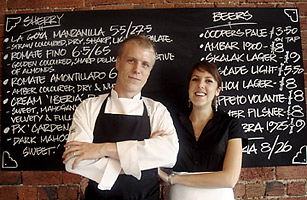
Tasty Tapas
Chef Jesse Gerner, left, and his wife Vanessa Gerner are the owners of Añada, a modern Spanish restaurant that is creating a buzz in Melbourne's funky Fitzroy District.
People tend to have a pretty good idea of what Sydney, Australia looks like, with its Opera House, harbor and of course, Bondi Beach. But Melbourne, the southern city on the banks of the Yarra River, which has an inner city population of only 86,000 because the vast majority of Melburnians live in the surrounding suburbs, is more enigmatic. "Sydney's about glamour and bikinis. We're about after dark," explains born-and-bred Melburnian, Karen Webster, who helms the city's annual fashion festival. "They live for the beach. We're foodies. We live to eat."
The term "foodie" is often heard in Melbourne, such a mecca for good eating, you could call it the Southern Hemisphere Paris. Certainly, securing a reservation at chef Shannon Bennett's Vue de monde can be as tough to get as a table for two at one of Joel Robuchon's establishments. Culinary creations by Bennett, 34, a native of Melbourne who looks more like a surfer than a super chef, include what he calls a "virtual gnocchi," a cep puree treated to an in-kitchen chemistry lesson which defines its shape, then served accompanied by sautéed king brown and shimeji mushrooms and zucchini flowers and finished with a tarragon emulsion. Another crowd pleaser is the bouillabaise which is presented at the table in a glass-toped, 1950s-style coffee percolator filled with aromatic shellfish stock. After this concoction is brought to a boil, it is poured into a bowl of tartares of crayfish and king fish cloaked in buffalo mozzarella.
Of course, many big cities these days have at least one restaurant which can challenge the best in the French capital, if not for stunning Belle Époque interiors, then certainly for surprising cuisine. However part of what makes Paris so unique is also the old-world charm of its eateries. Yet those too can be found in Melbourne, which, with its grand foundations in the 1850s Gold Rush, has a long history of fine French restaurants, their chefs being imported from France, and, from the 1920s onwards, robust Italian eateries where the chefs were émigrés, who stayed. The most bustling to this day is The Flo (which has no connection to the Paris brasserie chain), under whose Tuscan-inspired murals the likes of Lauren Bacall, Rock Hudson and Rudolf Nureyev have all dined. Today, the owner-chef is Guy Grossi, and Grossi Florentino, the Flo's proper name, also features a street-level outdoor cafe which opened in 1956 when Melbourne hosted the Olympic Games.
Ah, but what also makes Paris so delectable is constant reinvention. When the zinc bars become routine, there's always somewhere new to discover. Melbourne maintains a similar capacity for discovery, with a recent entry on the restaurant menu being Añada, opened by twenty-something husband and wife team, Jesse and Vanessa Gerner, (he's the chef, she runs front-of-house) in the funky Fitzroy neighborhood (Brooklyn's Williamsburg would be the New York equivalent). Locals are flocking here for tasty tapas plates such as white anchovies with hearts of palm or "raciones" (bigger plates) not only reminiscent of the Moorish tastes of Southern Spain, but also fulsome with the flavors of regional produce. Delicacies include slow-cooked South Western Highland pork belly doused with fennel seeds and smoky eggplant as well as Anson Bay clams from the nearby island state of Tasmania, brightened with La Goya Manzanilla and mint.
Melbourne is endowed with so many good restaurants, an aficionado of the city might wonder where the mentions are of favorite haunts like Flower Drum, Pearl, Circa, Stokehouse, Taxi, and MoVida, to name a few. Or, indeed, for the newest, Bistro Guillaume or Seamstress, the latter a fun eatery in a building that has housed both a brothel and a buddhist temple. As for the Paris comparison, Melbourne also echoes the best in today's Milan, Madrid, Tokyo, and Shanghai.
The rich culinary offering and heritage are due in part to the four seasons being much more distinct than, say, 550 miles to the north east in Sydney. Then there's the plethora of nature's bounty found within easy reach of a city surrounded by rich agricultural land and the sea. Produce for the world's cuisines is cultivated by passionate small growers, hence the city's bustling food markets. Although founded after Sydney, Melbourne was free-settled. (Think how that might have affected early expectations of what people put in their mouths).
While its wide boulevards, perfect for outdoor dining, are the legacy of its gold rush riches, Melbourne's varied palate comes from waves of immigration. The city has the biggest Greek population outside of Athens and, as for the Italians, mostly, they hail from a different generation to their "cousins" in America, many of them having left the turmoil of the cities of postwar Italy, (while in contrast, the majority of New York's 19th century Italian immigrants were the southern, rural poor). Thus Australia's Italian food, even as it arrived here, cut through the strict, regional divides of the home country, especially as those from the north wed those from the south, further mixing things up in the kitchen.